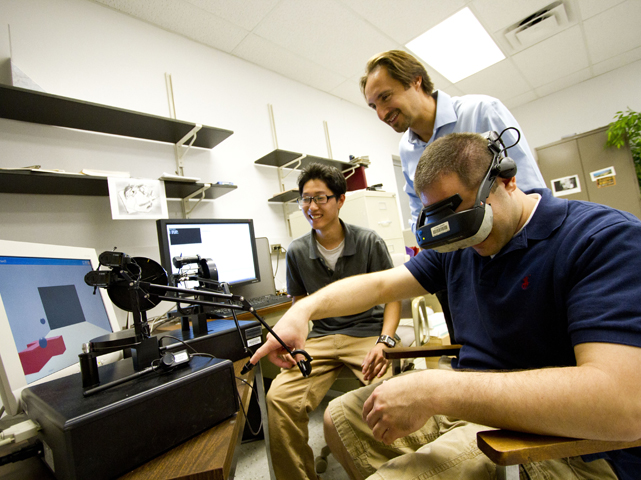
ASU-Mayo research project targets carpal tunnel syndrome diagnosis

Marco Santello (standing), director of the Neural Control of Movement Laboratory at Arizona State University, is collaborating with Mayo Clinic Arizona neurologist Mark Ross on carpal tunnel syndrome research. Photo: Jessica Slater/ASU
Posted August 5, 2013
Improved diagnosis for people afflicted with carpal tunnel syndrome – one of the most common disorders of the hand – is the goal of a research collaboration led by an Arizona State University biomedical engineering faculty member and a Mayo Clinic physician.
Marco Santello and Mark Ross were recently awarded a grant of $93,000 from Mayo’s Center for Regenerative Medicine to advance their effort to quantify the effects of carpal tunnel release surgery on patients’ recovery of sensorimotor hand function.
Santello is a professor and director of the School of Biological and Health Systems Engineering, one of ASU’s Ira A. Fulton Schools of Engineering. Ross is a professor of neurology at Mayo Clinic Arizona.
They hope results of the project will lead to continued funding of their research by the National Institutes of Health. Their collaboration, supported for the past five years by the institute, has revealed new knowledge about the effects of sensorimotor deficits caused by carpal tunnel syndrome on grasp control.
The new project focuses on a gap in the understanding of the effects of carpal tunnel release surgery, specifically the interaction of various factors that determine the extent of recovery of sensorimotor hand function after surgery.
Also known as carpal tunnel decompression surgery, the procedure involves dividing the transverse carpal ligament that runs across the hand so that the ligament no longer presses down on the nerves inside the hand, thus relieving debilitating pressure.
Findings by Santello and Ross to date have shown that carpal tunnel syndrome affects a variety of complex and subtle aspects of sensorimotor function. In the new project they will use a novel application of grasp testing they have developed to closely measure recovery of the function following surgery.
It is hoped the grasp tests can be used to help provide a way to more precisely measure functional recovery and enable early detection if a patient is not recovering as expected, the researchers say.
Beyond that advance, Santello and Ross intend to use the grasp tests to provide quick, simple, noninvasive and inexpensive quantification of patients’ progress in recovery from pre-operative nerve injury after carpal tunnel release surgery.
Media Contact:
Joe Kullman, [email protected]
(480) 965-8122
Ira A. Fulton Schools of Engineering



































